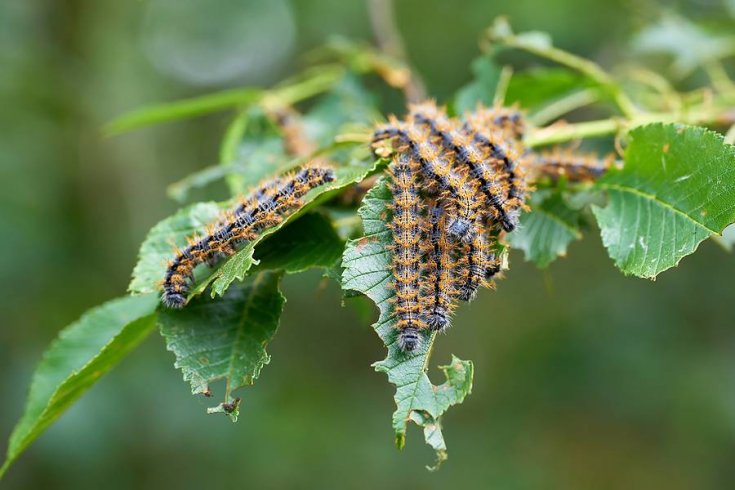Menu
Trees are more than towering structures of bark and leaves; their roots play a crucial role in their overall health and vitality. Tree roots serve several vital functions, including extracting nutrients and water from the soil, storing food, and anchoring the tree securely to the ground. However, when a tree’s root system suffers damage, it can lead to a steady decline in its health, eventually becoming a safety hazard. If you suspect a problem with your tree, consult a professional tree care company. At the Driscoll Tree Service, we leverage extensive expertise and proven strategies to inspect, diagnose, and address root problems before things get out of hand. Here are common signs of tree root damage and how to identify them early to prevent further deterioration and costly tree removal emergencies.

One of the first visible signs of tree root damage is fungal fruiting bodies near the tree’s base. These are often referred to as “mushrooms” or “toadstools.” While mushrooms might seem harmless or even picturesque, they are a clear sign of underlying issues with a tree’s roots.
Fungal fruiting bodies show that the tree’s root system may decay, allowing fungi to thrive on the decaying organic matter. As the fungi break down the wood, they compromise the structural integrity of the roots. When you spot these growths around the base of a tree, call a tree service immediately.
Leaf scorch is another noticeable sign of potential root damage. This condition occurs when the tree’s roots cannot supply sufficient water to the leaves. This causes the edges of the leaves to turn brown or appear burnt. Leaf scorch can affect the overall aesthetics of the tree, causing the decline of the entire tree.
Schedule routine inspections with a reputable tree care company to detect leaf scorch early. Arborists can see telltale signs like brown or crispy leaf edges, which often start at the tips and work their way inward. Early intervention, such as proper irrigation, can prevent this issue and further root damage.
When a tree’s root system is compromised, it may struggle to support its branches with essential nutrients and water. Branch dieback is a symptom of this struggle. It involves the gradual death of branches, starting from the tips and moving toward the trunk. You might notice that some branches lose their leaves, wither, or develop a lackluster appearance.
Branch dieback can occur in isolated areas or affect the entire tree, depending on the extent of root damage. Once you notice branch dieback, hire reliable arborists to improve the tree’s overall health and appearance.

Yellowing leaves can show various tree health issues, including root damage. When the root system is compromised, it can lead to poor nutrient uptake, resulting in leaves that turn yellow instead of their healthy green color.
To identify this issue, closely inspect the tree’s foliage. If you notice a general yellowing of leaves, especially unrelated to seasonal changes, it’s essential to consult a trusted tree service. Soil testing and fertilization can help address nutrient deficiencies caused by root damage.
A tree’s roots are its lifeline, providing vital support and sustenance. Recognizing the signs of root damage early is crucial to preserving the health and longevity of your trees. If you observe these signs of deterioration, contact the Driscoll Tree Service. Our certified arborists can diagnose the root problem and determine the best action to ensure optimal health and prevent costly tree removal projects.

How to Keep Your Trees Healthy Keeping trees healthy is not just essential for the aesthetics and safety of your landscape but also improves the quality of the environment. However, like other living things, trees need routine care and maintenance…
Read More
Can You Remove Trees & Stumps During Winter? Trees offer a wide range of benefits for the environment and your home. However, winter confines most people indoors, reducing the time to enjoy outdoor spaces. Homeowners usually overlook yard care during…
Read More
How to Help Flooded Trees & Shrubs Flooding can cause significant damage to trees and shrubs, especially if water remains stagnant for long. While these plants are resilient, excess water can weaken their root systems and affect their growth, causing…
Read More
Things That Might Kill Your Beautiful Trees Homeowners strive to have a gorgeous yard with stunning trees. However, routine care is essential to maintain optimal health and longevity. At Driscoll Tree Service, we aim to help you keep your trees…
Read More
Why are My Tree Branches Falling Off? As the summer temperatures rise, the tranquility of your garden may be disrupted by branches falling off your trees. Unlike the more common storm or ice damage, these occurrences can leave you puzzled,…
Read More
Tree Pruning: DIY vs. Hiring a Professional Trees rarely need any maintenance in the winter because they are dormant. However, spring is around the corner and offers property owners a chance to prune trees in the backyard. It is advisable…
Read More
What is Tree Cabling? Trees are vital to our environment, providing shade, beauty, and ecological benefits. However, sometimes trees develop structural weaknesses that cause dangerous situations or loss premature tree removal emergencies. With that in mind, tree cabling allows property…
Read More
Do's and Don'ts of Tree Planting As winter approaches and the rains approach, it is an excellent time for tree planting. Trees are a valuable addition to any landscape; like other living things, they need regular maintenance and care. At…
Read More
Are Holes in Trees Dangerous? Trees are magnificent entities that play a vital role in our environment. Despite the many benefits, from offering shade beauty to oxygen, many trees develop holes, causing concerns about their health and safety. If you…
Read More
How to Fix Evergreen Trees Turning Brown Evergreen trees are known for their lush foliage that remains vibrant throughout the year, providing beauty and stability to our landscapes. However, when those green needles or leaves turn brown, it’s often a…
Read More